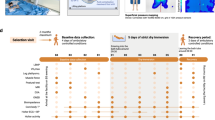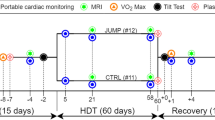Abstract
Introduction
Experiments during spaceflight and simulated microgravity as head-down tilt bedrest, demonstrated the role of arterial stiffness among others, in microgravity induced cardiovascular pathologies and emphasized the need for a robust countermeasure.
Aim
The purpose of the present study was to evaluate the use of a new countermeasure, consisting of a high intensity Reactive Sledge (RSL) jumps training protocol, to counteract changes in arterial stiffness during long term head down tilt bedrest (LTBR).
Methods
The participants enrolled in the study were 23 male, healthy volunteers, aged between 20 and 45 years, subjected to LTBR for 60 days and randomly assigned either to a control (11) or to a training sledge (12) group using RSL 3–4 times per week, as a countermeasure. Recorded values were systolic and diastolic blood pressure, heart rate and the user’s arterial stiffness index.
Results
Compared to baseline measurements, there was a deterioration in the values of arterial stiffness, systolic and diastolic blood pressure and heart rate, in both groups until day 35 of LTBR, interpreted as adaptation to the microgravity environment. From this day until the end of the experiment, arterial stiffness of the control group was constantly fluctuating, while constantly improving for the training group. During the recovery period, arterial stiffness values returned to the pre-experimental levels in both groups.
Conclusions
Overall, arterial stiffness increased the longer the time spent in LTBR and the countermeasure was partially effective in preventing the observed phenomenon.
German Clinical Trials Register (DRKS), DRKS00012946, September 18, 2017, retrospectively registered




Similar content being viewed by others
References
Wolfe JW, Rummel JD. Long-term effects of microgravity and possible countermeasures. Adv Space Res. 1992;12(1):281–4.
Convertino V, Hoffler GW. Cardiovascular physiology. Effects of microgravity. J Fla Med Assoc. 1992;79(8):517–24.
Tuday EC, Nyhan D, Shoukas AA, Berkowitz DE. Simulated microgravity-induced aortic remodeling. J Appl Physiol. 2009;106(6):2002–8.
Cattan V, Kakou A, Louis H, Lacolley P. Pathophysiology, genetic, and therapy of arterial stiffness. Biomed Mater Eng. 2016;16(4):155–61.
Mitchell GF. Effects of central arterial aging on the structure and function of the peripheral vasculature: implications for end-organ damage. J Appl Physiol. 2008;105(5):1652–60.
Mitchell GF, Hwang SJ, Vasan RS, et al. Arterial stiffness and cardiovascular events: the Framingham Heart Study. Circulation. 2010;121(4):505–11.
Zieman SJ, Melenovsky V, Kass DA. Mechanisms, pathophysiology, and therapy of arterial stiffness. Arterioscler Thromb Vasc Biol. 2005;25(5):932–43.
Williams D, Kuipers A, Mukai C, Thirsk R. Acclimation during space flight: effects on human physiology. CMAJ. 2009;180(13):1317–23.
Nosova EV, Yen P, Chong KC, et al. Short-term physical inactivity impairs vascular function. J Surg Res. 2014;190(2):672–82.
Kaibe M, Ohishi M, Komai N, et al. Arterial stiffness index; a new evaluation for arterial stiffness in elderly patients with essential hypertension. Geriatr Gerontol Int. 2002;2:199–203.
Carvil P, Baptista R, Russomano T. The human body in a microgravity environment: long term adaptations and countermeasures. Aviat Focus J Aeronaut Sci. 2013;4(1):10–22.
Shimazu H. Method for and evaluation of the indirect measurement of arterial stiffness index, 2017.
Kramer A, Kümmel J, Mulder E, Gollhofer A, Frings-Meuthen P, Gruber M. High-intensity jump training is tolerated during 60 days of bed rest and is very effective in preserving leg power and lean body mass: an overview of the Cologne RSL Study. PLoS ONE. 2017;12:e0169793.
Hughson R, Greaves DK, Arbeille P. Vascular adaptations to spaceflight: results from the vascular series experiments. Rev Cuba Investig Bioméd. 2019;38:3.
Zhou Y, Yang R, Li C, Tao M. Sleep disorder, an independent risk associated with arterial stiffness in menopause. Sci Rep. 2017;7(1):1–8.
Dinenno FA, Jones PP, Seals DR, Tanaka H. Age-associated arterial wall thickening is related to elevations in sympathetic activity in healthy humans. Am J Physiol Heart Circ Physiol. 2002;278(4):1205–10.
Shirwany NA, Zou MH. Arterial stiffness: a brief review. Acta Pharmacol Sin. 2010;31(10):1267–76.
Komorowski M, Fleming S, Kirkpatrick AW. Fundamentals of anesthesiology for spaceflight. J Cardiothorac Vasc Anesth. 2016;30(3):781–90.
Kramer A, Ritzmann R, Gruber M, Gollhofer A. Four weeks of training in a sledge jump system improved the jump pattern to almost natural reactive jumps. Eur J Appl Physiol. 2012;112(1):285–93.
Ferreira I, Boreham CA, Stehouwer CD. The benefits of exercise for arterial stiffness. Am J Hypertens. 2006;19(10):1037–8.
Shibata S, Fujimoto N, Hastings JL, et al. The effect of lifelong exercise frequency on arterial stiffness. J Physiol. 2018;596(14):2783–95.
Tanaka H. Effects of regular exercise on arterial stiffness. In: Pescatello L, editor. Effects of exercise on hypertension. New Jersey (NJ): Humana Press; 2015. p. 185–201.
Yoon ES, Jung SJ, Cheun SK, Oh YS, Kim SH, Jae SY. Effects of acute resistance exercise on arterial stiffness in young men. Korean Circ J. 2010;40(1):16–22.
Pierce DR, Doma K, Raiff H, Golledge J, Leicht AS. Influence of exercise eode on post-exercise arterial stiffness and pressure wave measures in healthy adult males. Front Physiol. 2018;9:1468.
Ashor AW, Lara J, Siervo M, Celis-Morales C, Mathers JC. Effects of exercise modalities on arterial stiffness and wave reflection: a systematic review and meta-analysis of randomized controlled trials. PLoS ONE. 2014;9(10):e110034.
Pierce DR, Doma K, Leicht AS. Acute effects of exercise mode on arterial stiffness and wave reflection in healthy young adults: a systematic review and meta-analysis. Front Physiol. 2018;9:73.
Miyachi M. Effects of resistance training on arterial stiffness: a meta-analysis. Br J Sports Med. 2013;47(6):393–6.
Au JS, Oikawa SY, Morton RW, MacDonald MJ, Phillips SM. Arterial stiffness is reduced regardless of resistance training load in young men. Med Sci Sports Exerc. 2017;49(2):342–8.
Tuday CE, Platts HS, Nyhan D, Shoukas AA, Berkowitz ED. A retrospective analysis on gender differences in the arterial stiffness response to microgravity exposure. Gravit Space Res. 2011;25:1.
Button K, Ioannidis J, Mokrysz C, et al. Power failure: why small sample size undermines the reliability of neuroscience. Nat Rev Neurosci. 2013;14:365–76.
Kullo IJ, Malik AR. Arterial ultrasonography and tonometry as adjuncts to cardiovascular risk stratification. J Am Coll Cardiol. 2007;49(13):1413–26.
Author information
Authors and Affiliations
Corresponding author
Ethics declarations
Funding
This bed rest study was funded by the European Space Agency (4000113871-15-NL). The construction of the sledge jump system was also funded by the European Space Agency (ESA Life Sciences Program TEC/MMG/2006/82).
Conflict of interest
There are no conflicts of interest.
Ethics approval
This study was performed in line with the principles of the Declaration of Helsinki. Approval was granted by the ethics committee of the Northern Rhine Medical Association (Arztekammer Nordrhein) in Duesseldorf, Germany, and the Federal Office for Radiation Protection (Bundesamt für Strahlenschutz).
Consent to participate
After being fully informed of procedures and aims of the study, all participants signed a written informed consent, valid for all the experimental aspects of the study.
Availability of data and materials
Data supporting the conclusions of this article will be made available by the corresponding author upon request.
Rights and permissions
About this article
Cite this article
Krachtis, A., Karkala, A., Frantzidis, C.A. et al. Arterial Stiffness Alterations in Simulated Microgravity and Reactive Sledge as a Countermeasure. High Blood Press Cardiovasc Prev 29, 65–74 (2022). https://doi.org/10.1007/s40292-021-00486-2
Received:
Accepted:
Published:
Issue Date:
DOI: https://doi.org/10.1007/s40292-021-00486-2




